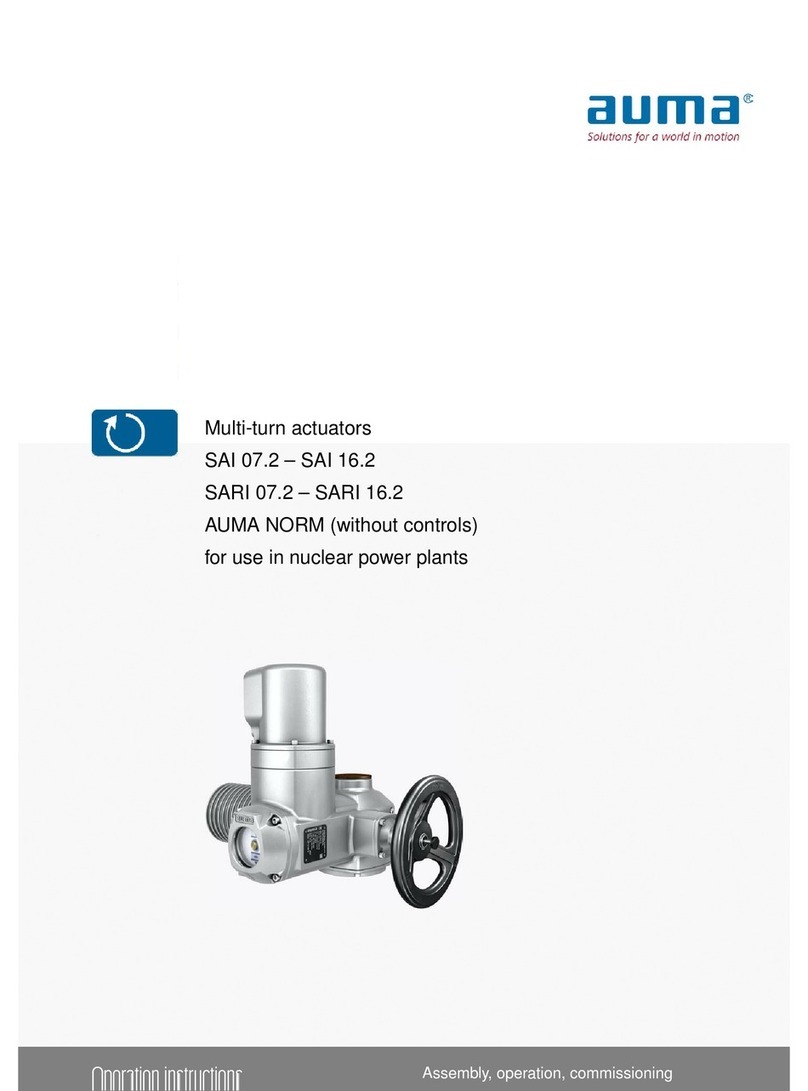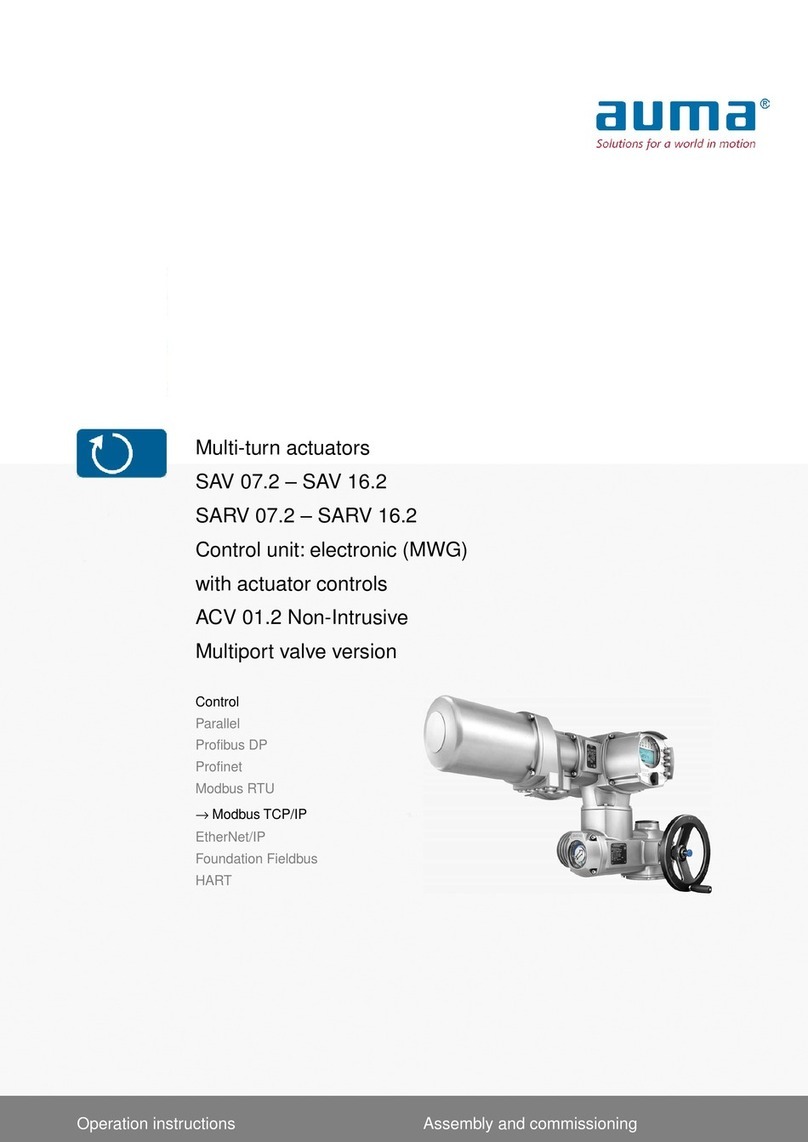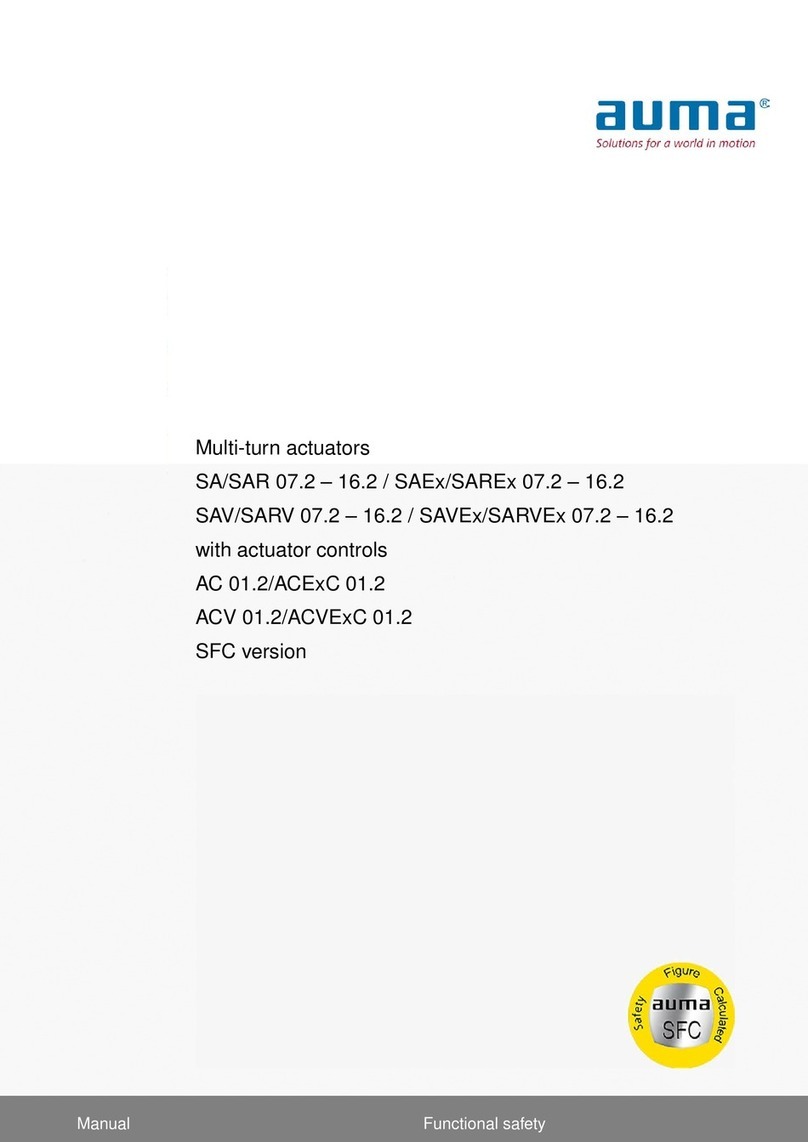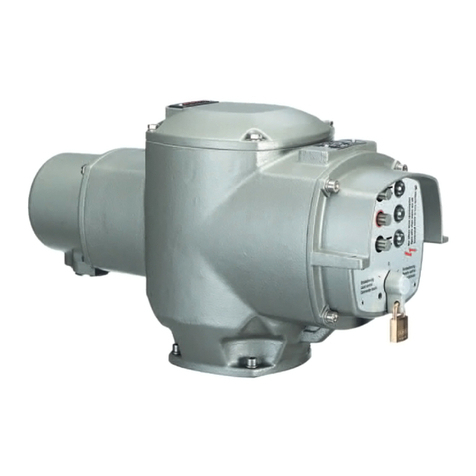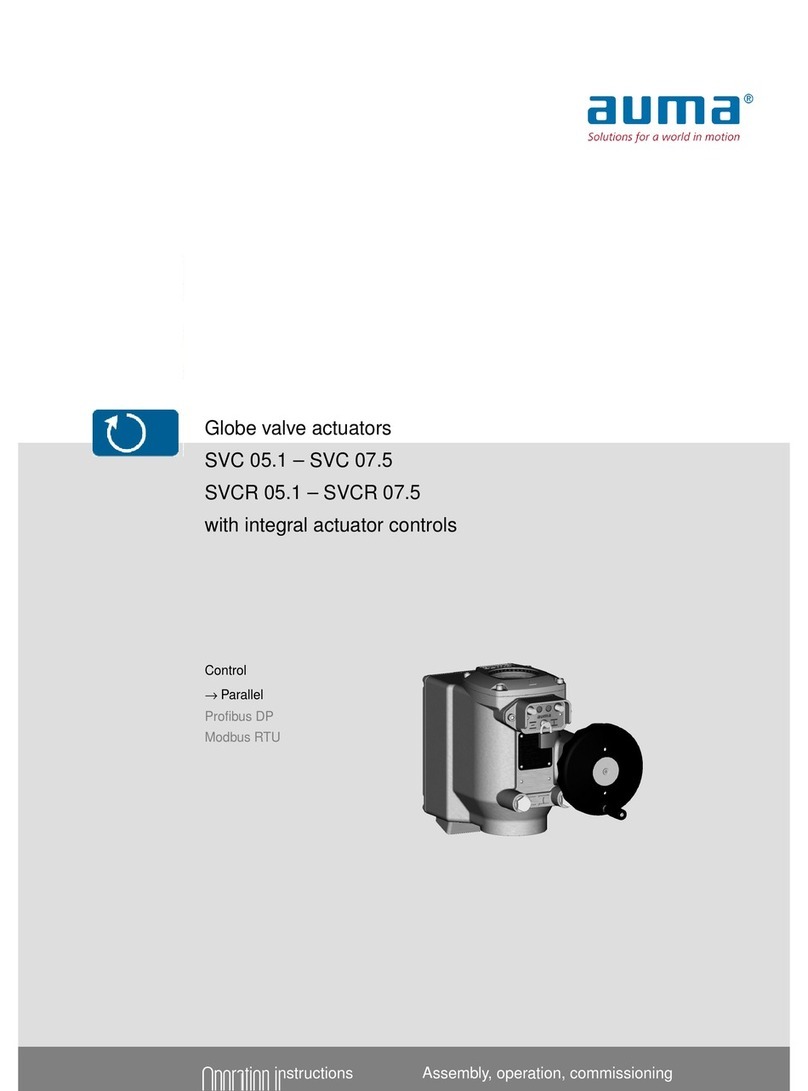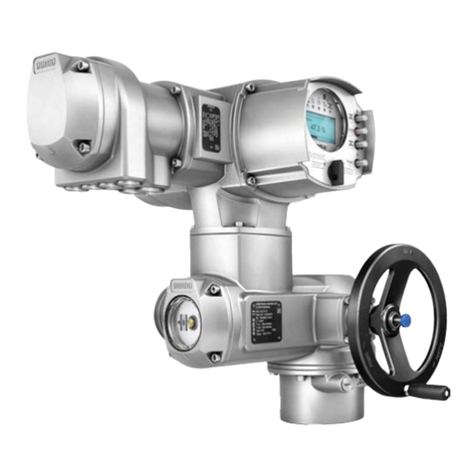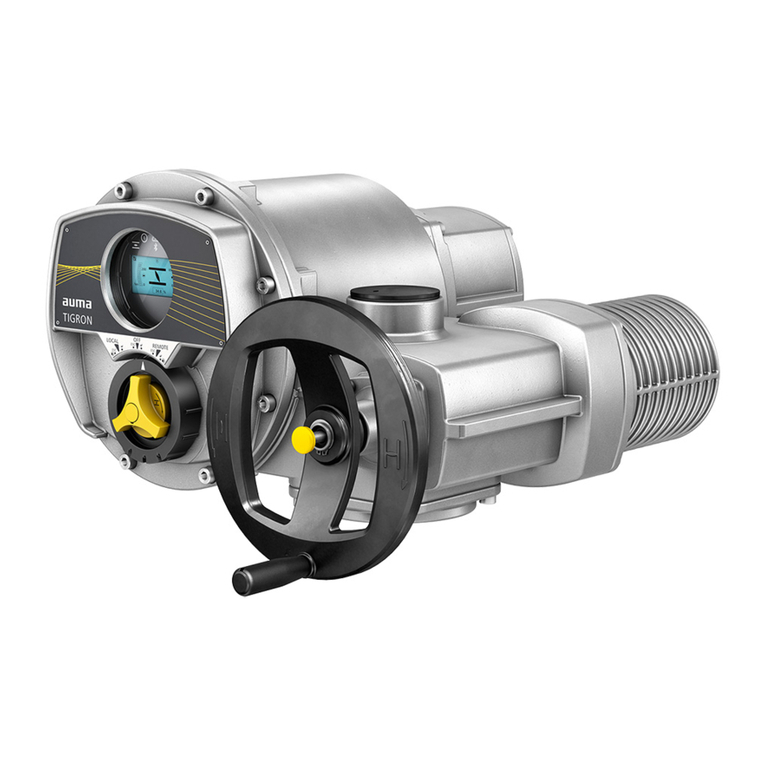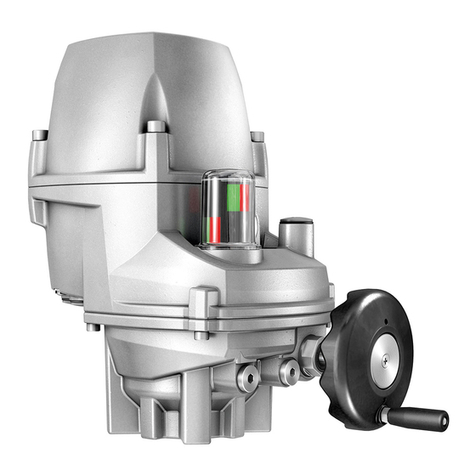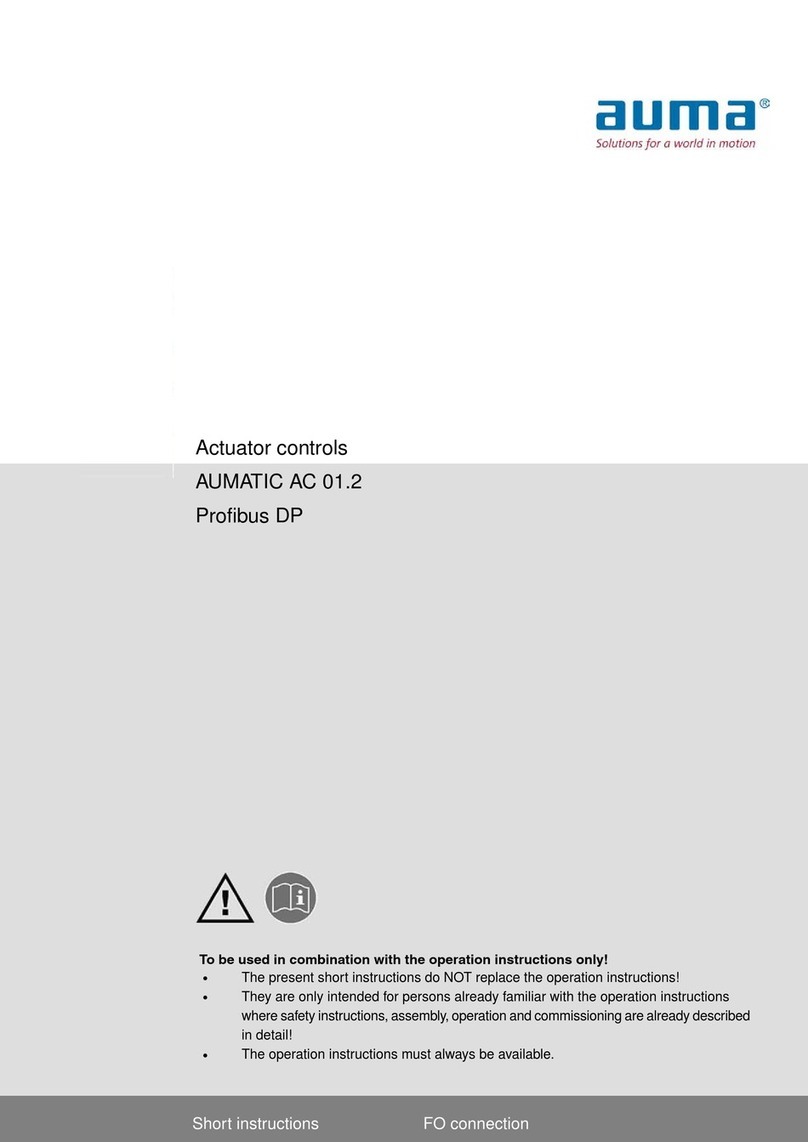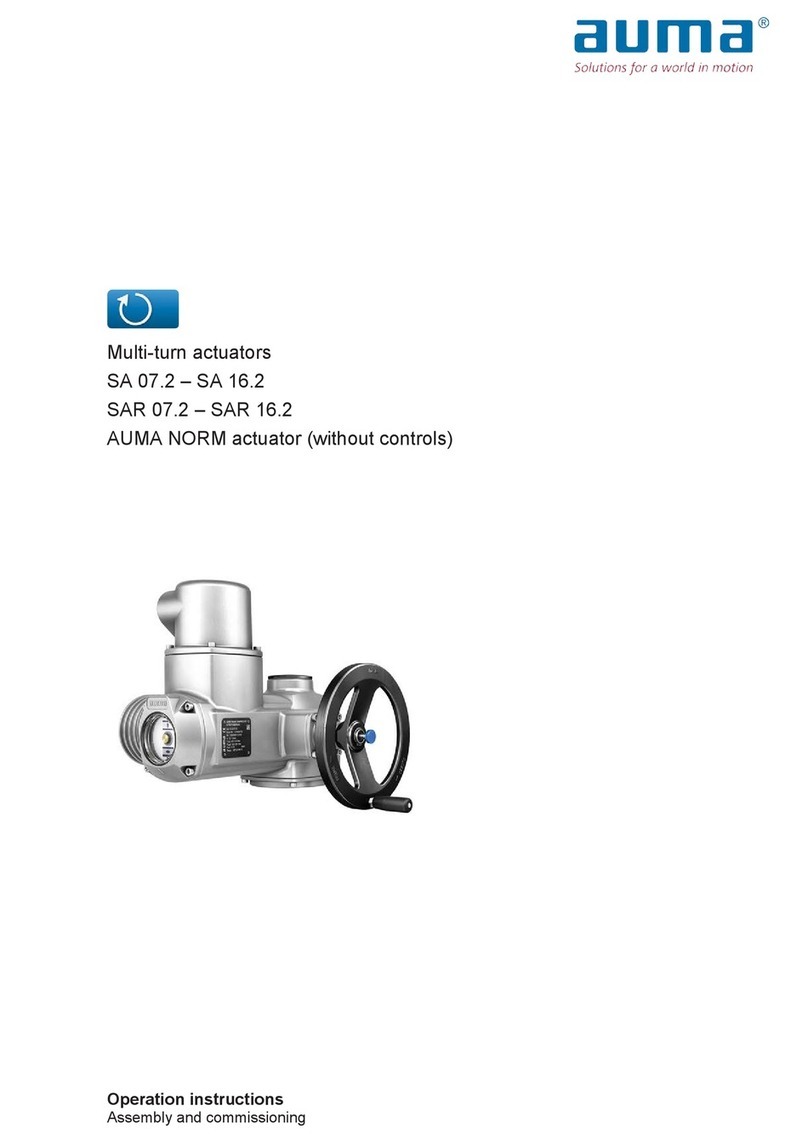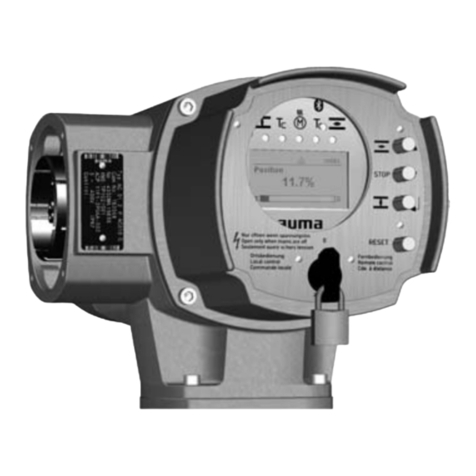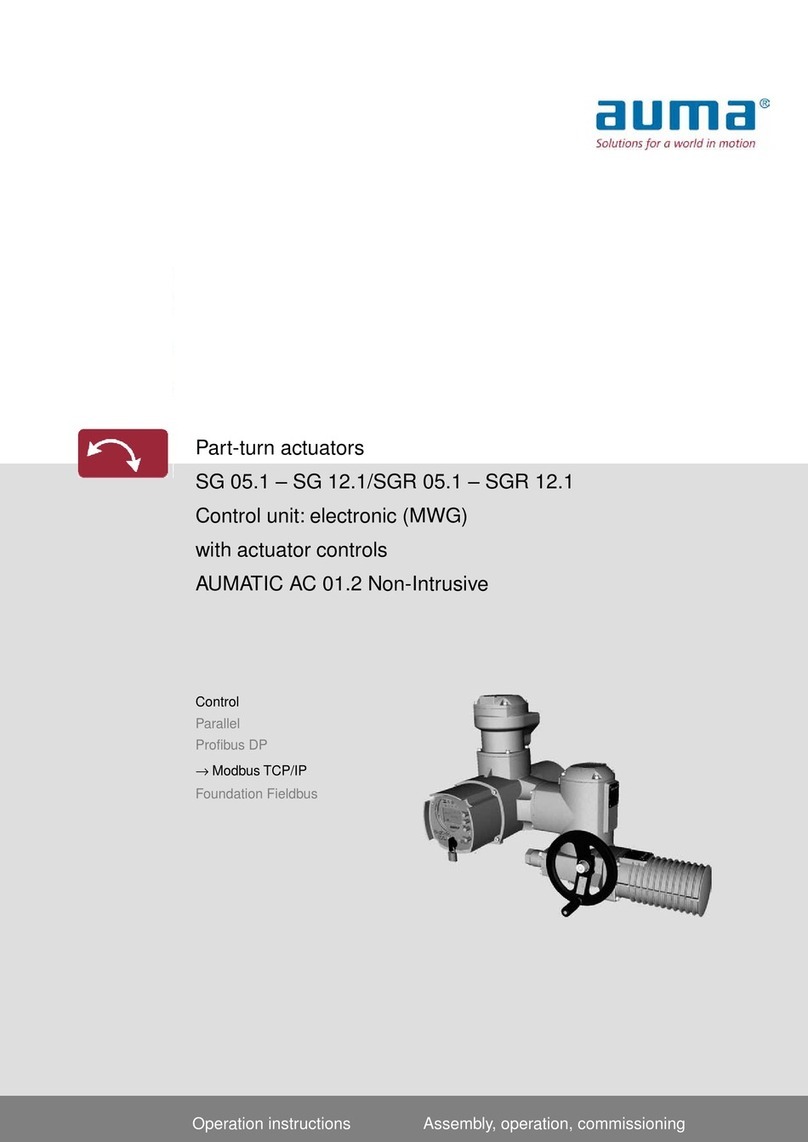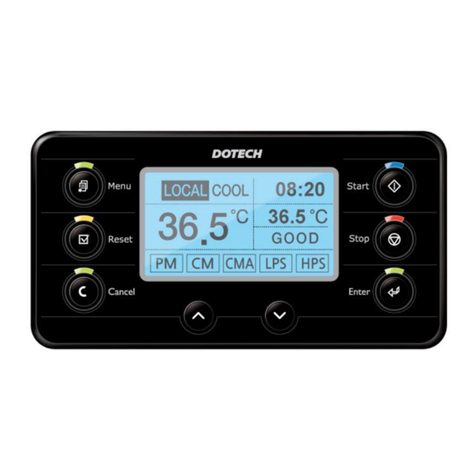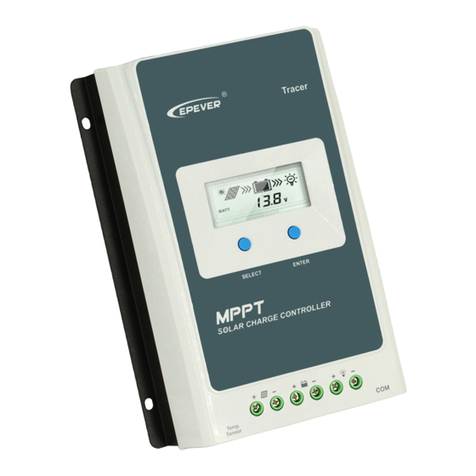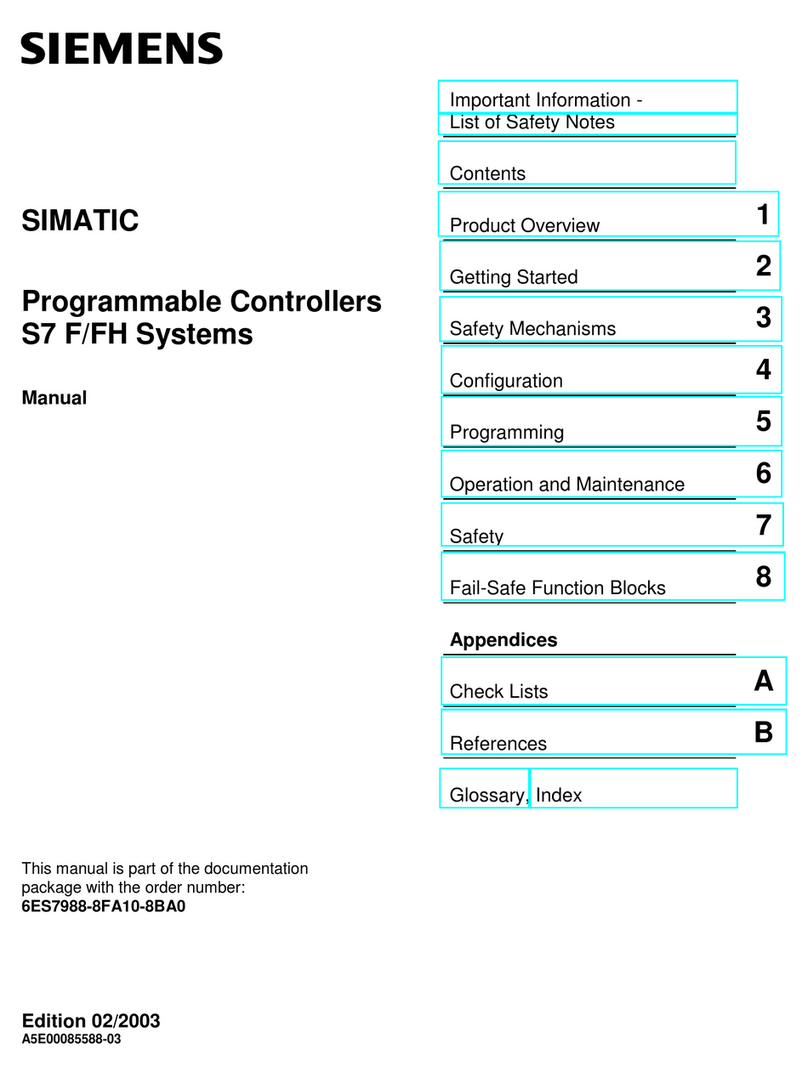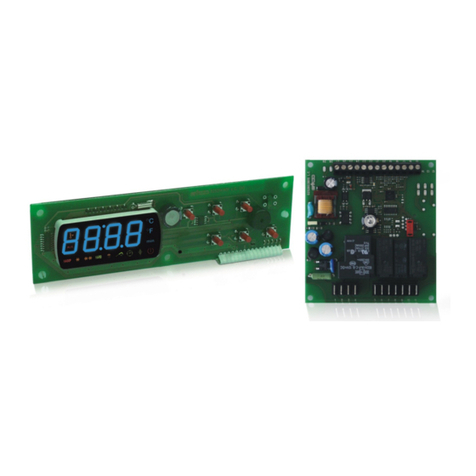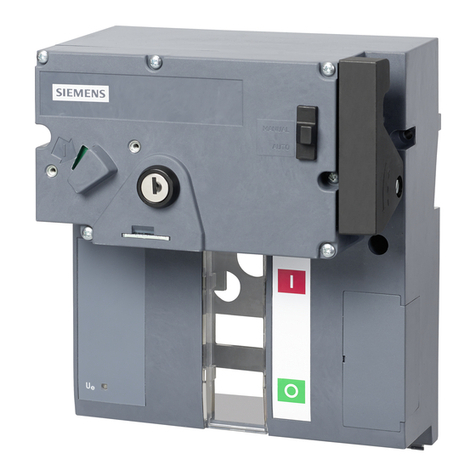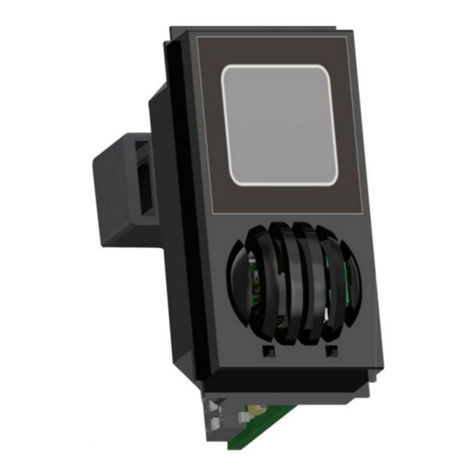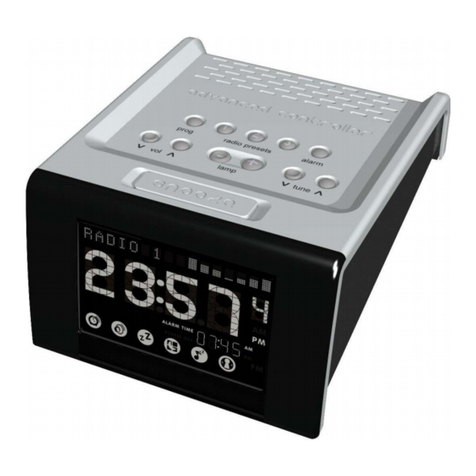AUMA SAV Series User manual

Control
Parallel
Profibus DP
Profinet
Modbus RTU
→Modbus TCP/IP
Foundation Fieldbus
HART
Multi-turn actuators
SAV 07.2 –SAV 16.2
SARV 07.2 –SARV 16.2
Control unit: electronic (MWG)
with actuator controls
ACV 01.2 Non-Intrusive
Assembly, operation, commissioningOperation instructions

Read operation instructions first.
●Observe safety instructions.
●These operation instructions are part of the product.
●Store operation instructions during product life.
●Pass on instructions to any subsequent user or owner of the product.
Target group:
This document contains information for assembly, commissioning and maintenance staff.
Reference documents:
●Manual (Operation and setting ) of actuator controls ACV 01.2 Modbus TCP/IP
●Manual (Fieldbus device integration) of actuator controls ACV 01.2 Modbus TCP/IP
Reference documents can be downloaded from the Internet (www.auma.com) or ordered directly from AUMA
(refer to <Addresses>).
Table of contents Page
51. Safety instructions................................................................................................................. 51.1. Prerequisites for the safe handling of the product 51.2. Range of application 61.3. Applications in Ex zone 22 (option) 71.4. Warnings and notes 71.5. References and symbols
92. Identification........................................................................................................................... 92.1. Name plate 122.2. Short description
133. Transport, storage and packaging........................................................................................ 133.1. Transport 143.2. Storage 153.3. Packaging
164. Assembly................................................................................................................................ 164.1. Mounting position 164.2. Handwheel fitting 164.3. Multi-turn actuator: mount to valve/gearbox 164.3.1. Output drive type A 174.3.1.1. Stem nut: finish machining 184.3.1.2. Multi-turn actuator (with output drive type A):mount to valve 194.3.2. Output drive types B and E 204.3.2.1. Multi-turn actuator with output drive types B:mount to valve/gearbox 214.4. Accessories for assembly 214.4.1. Stem protection tube for rising valve stem 224.5. Mounting positions of local controls 234.5.1. Mounting positions: modify
245. Electrical connection............................................................................................................. 245.1. Basic information 275.2. SJ electrical connection (AUMA plug/socket connector) 285.2.1. Terminal compartment (for mains connection): open 295.2.2. Cable connection
2
SAV 07.2 –SAV 16.2 / SARV 07.2 –SARV 16.2 Control unit: electronic (MWG)
Table of contents ACV 01.2 Modbus TCP/IP

305.2.3. Terminal compartment (for mains connection): close 315.2.4. Fieldbus terminal compartment: open 315.2.5. Industrial Ethernet cable:connect 325.2.6. Fieldbus terminal compartment: close 335.3. Accessories for electrical connection 335.3.1. Actuator controls on wall bracket 335.3.2. Parking frame 345.3.3. DS intermediate frame for double sealing 345.3.4. External earth connection
356. Operation................................................................................................................................ 356.1. Manual operation 356.1.1. Engage manual operation 356.1.2. Manual operation: disengage 366.2. Motor operation 366.2.1. Local actuator operation 376.2.2. Actuator operation from remote 376.3. Menu navigation via push buttons (for settings and indications) 386.3.1. Menu layout and navigation 396.4. User level, password 396.4.1. Password entry 406.4.2. Password change 406.5. Language in the display 416.5.1. Language change
427. Indications.............................................................................................................................. 427.1. Indications during commissioning 427.2. Indications in the display 437.2.1. Feedback indications from actuator and valve 457.2.2. Status indications according to AUMA classification 467.2.3. Status indications according to NAMUR recommendation 487.3. Indication lights of local controls 497.4. Optional indications 497.4.1. Mechanical position indication via indicator mark 497.4.2. Mechanical position indication (self-adjusting)
508. Signals (output signals)......................................................................................................... 508.1. Status signals via output contacts (digital outputs) 508.1.1. Assignment of outputs 508.1.2. Coding the outputs 508.2. Analogue signals (analogue outputs)
519. Commissioning (basic settings)........................................................................................... 519.1. Type of seating: set 529.2. Torque switching: set 539.3. Limit switching: set 559.4. Output speed (internal): set 579.5. Fieldbus address (slave address), baud rate, parity and monitoring time: set 579.5.1. Modbus TCP/IP gateway: set 579.6. Test run 579.6.1. Direction of rotation at mechanical position indicator: check 589.6.2. Direction of rotation at hollow shaft/stem: check 599.6.3. Limit switching: check
3
SAV 07.2 –SAV 16.2 / SARV 07.2 –SARV 16.2 Control unit: electronic (MWG)
ACV 01.2 Modbus TCP/IP Table of contents

6010. Commissioning (settings/options in the actuator)............................................................. 6010.1. Switch compartment: open/close 6110.2. Mechanical position indicator (self-adjusting) 6110.2.1. Mechanical position indicator: set 6210.2.2. Gear stage of the reduction gearing: test/set 6310.3. Mechanical position indication via indicator mark (not self-adjusting) 6310.3.1. Mechanical position indicator: set 6410.3.2. Gear stage of the reduction gearing: test/set
6711. Corrective action.................................................................................................................... 6711.1. Faults during commissioning 6711.2. Fault indications and warning indications 7111.3. Fuses 7111.3.1. Fuses within the actuator controls 7111.3.2. Motor protection (thermal monitoring)
7212. Servicing and maintenance................................................................................................... 7212.1. Preventive measures for servicing and safe operation 7312.2. Maintenance 7312.3. Disposal and recycling
7413. Technical data......................................................................................................................... 7413.1. Technical data Multi-turn actuators 7613.2. Technical data Actuator controls
8214. Spare parts............................................................................................................................. 8214.1. Multi-turn actuators SA(V) 07.2 –SA(V) 16.2/SAR(V) 07.2 –SAR(V) 16.2 8414.2. ACV 01.2 SJ actuator controls
8615. Certificates.............................................................................................................................. 8615.1. Declaration of Incorporation and EU Declaration of Conformity
87Index........................................................................................................................................
90Addresses...............................................................................................................................
4
SAV 07.2 –SAV 16.2 / SARV 07.2 –SARV 16.2 Control unit: electronic (MWG)
Table of contents ACV 01.2 Modbus TCP/IP

1. Safety instructions
1.1. Prerequisites for the safe handling of the product
Standards/directives The end user or the contractor must ensure that all legal requirements, directives,
guidelines, national regulations and recommendations with respect to assembly,
electrical connection, commissioning and operation are met at the place of installation.
They include among others:
●Applicable configuration guidelines for network applications.
Safety instructions/
warnings All personnel working with this device must be familiar with the safety and warning
instructions in this manual and observe the instructions given. Safety instructions
and warning signs on the device must be observed to avoid personal injury or property
damage.
Qualification of staff Assembly, electrical connection, commissioning, operation, and maintenance must
be carried out by suitably qualified personnel authorised by the end user or contractor
of the plant only.
Prior to working on this product, the staff must have thoroughly read and understood
these instructions and, furthermore, know and observe officially recognised rules
regarding occupational health and safety.
Commissioning Prior to commissioning, imperatively check that all settings meet the requirements
of the application. Incorrect settings might present a danger to the application, e.g.
cause damage to the valve or the installation.The manufacturer will not be held
liable for any consequential damage. Such risk lies entirely with the user.
Operation Prerequisites for safe and smooth operation:
●Correct transport, proper storage, mounting and installation, as well as careful
commissioning.
●Only operate the device if it is in perfect condition while observing these instruc-
tions.
●Immediately report any faults and damage and allow for corrective measures.
●Observe recognised rules for occupational health and safety.
●Observe national regulations.
●During operation,thehousingwarms up and surfacetemperatures>60°Cmay
occur.To prevent possible burns, we recommend checking the surface temper-
ature using an appropriate thermometer and wearing protective gloves, prior
to working on the device.
Protective measures The end user or the contractor are responsible for implementing required protective
measures on site, such as enclosures, barriers, or personal protective equipment
for the staff.
Maintenance To ensure safe device operation, the maintenance instructions included in this manual
must be observed.
Any device modification requires prior written consent of the manufacturer.
1.2. Range of application
AUMA multi-turn actuators are designed for the operation of industrial valves, e.g.
globe valves, gate valves, butterfly valves, and ball valves.
Other applications require explicit (written) confirmation by the manufacturer.
The following applications are not permitted, e.g.:
●Industrial trucks according to EN ISO 3691
●Lifting appliances according to EN 14502
●Passenger lifts according to DIN 15306 and 15309
5
SAV 07.2 –SAV 16.2 / SARV 07.2 –SARV 16.2 Control unit: electronic (MWG)
ACV 01.2 Modbus TCP/IP Safety instructions

●Service lifts according to EN 81-1/A1
●Escalators
●Continuous duty
●Buried service
●Continuous submersion (observe enclosure protection)
●Potentially explosive areas, with the exception of zone 22
●Radiation exposed areas in nuclear power plants
No liability can be assumed for inappropriate or unintended use.
Observance of these operation instructions is considered as part of the device's
designated use.
Information These operation instructions are only valid for the "clockwise closing" standard
version, i.e. driven shaft turns clockwise to close the valve.
1.3. Applications in Ex zone 22 (option)
Actuators of the indicated series basically meet the requirements for applications in
dust hazardous locations of ZONE 22 in compliance with the ATEX directive
2014/34/EU.
To comply with all requirements of the ATEX directive, observe the following points:
●Actuators are marked with the explosion protection designation II3D... for use
in ZONE 22.
●Maximum surface temperature of actuators
- T150 °C for ambient temperatures up to +60 °C or
- T190 °C for ambient temperatures up to +80 °C.
Increased dust deposit on the equipment was not considered for the determin-
ation of the maximum surface temperature.
●The following conditions must be fulfilled to respect the maximum permissible
surface temperatures at the actuator:
- Respecting types of duty and technical manufacturer data
- Correct connection of thermal motor protection (thermoswitches or PTC
thermistor)
Table 1: Maximum
surface temperature
Tripping temperature
Thermal motor protection
Ambient temperature
T150 °C140 °Cup to +60 °C
T190 °C155 °Cup to +80 °C
●The connector may only be connected or disconnected when not live.
●The cable glands and cable entries used have to meet the requirements of
category II3D and must at least comply with enclosure protection IP67.
●The actuators must be connected by means of an external earth connection
(accessory part) to the equipotential earth bonding or integrated into an earthed
piping system.
●To ensure combustible dust hazard protection, seal hollow shaft against ingress
of dust:
- Using threaded plug (ref. no.511.0) and appropriate seal
- Using metallic stem protection tube, protective cap and V-seal (ref.no.
568.1, 568.2, 568.3) for rising valve stem
●As a general rule, the requirements of IEC 60079 Parts 14 and 17 must be re-
spected in dust hazardous locations.During commissioning, service, and
maintenance, special care as well as qualified and trained personnel are required
for safe actuator operation.
6
SAV 07.2 –SAV 16.2 / SARV 07.2 –SARV 16.2 Control unit: electronic (MWG)
Safety instructions ACV 01.2 Modbus TCP/IP

1.4. Warnings and notes
The following warnings draw special attention to safety-relevant procedures in these
operation instructions, each marked by the appropriate signal word (DANGER,
WARNING, CAUTION, NOTICE).
Indicates an imminently hazardous situation with a high level of risk. Failure
to observe this warning results in death or serious injury.
Indicates a potentially hazardous situation with a medium level of risk.Failure
to observe this warning could result in death or serious injury.
Indicates a potentially hazardous situation with a low level of risk. Failure to
observe this warning could result in minor or moderate injury. May also be
used with property damage.
Potentially hazardous situation. Failure to observe this warning could result
in property damage. Is not used for personal injury.
Safety alert symbol warns of a potential personal injury hazard.
The signal word (here: DANGER) indicates the level of hazard.
1.5. References and symbols
The following references and symbols are used in these instructions:
Information The term Information preceding the text indicates important notes and information.
Symbol for CLOSED (valve closed)
Symbol for OPEN (valve open)
Via the menu to parameter
Describes the menu path to the parameter.When using the push buttons of local
controls, the required parameter can be quickly found on the display. Display texts
are shaded in grey: Display.
Wiring diagram Texts extracted from other documents
Texts extracted from other documents are highlighted in a different font.For example
Wiring diagram.
< > Reference to other sections
Terms in brackets shown above refer to other sections of the document which provide
further information on this topic.These terms are either listed in the index, a heading
or in the table of contents and may easily be located.
Warning signs at the device
The following warning signs can be attached to the device.
General warning sign
General warning of a danger zone.
Hot surface
Warning of hot surfaces, e.g.possibly caused by high ambient temperatures or strong
direct sunlight.
7
SAV 07.2 –SAV 16.2 / SARV 07.2 –SARV 16.2 Control unit: electronic (MWG)
ACV 01.2 Modbus TCP/IP Safety instructions

Electrical voltage
Hazardous voltage! Warning of electric shock.At some devices, the warning sign
additionally includes a time interval, e.g.30 s.Once power supply is switched off,
you will have to wait for the indicated period. Only then may the device be opened.
8
SAV 07.2 –SAV 16.2 / SARV 07.2 –SARV 16.2 Control unit: electronic (MWG)
Safety instructions ACV 01.2 Modbus TCP/IP

2. Identification
2.1. Name plate
Figure 1: Arrangement of name plates
[1] Actuator name plate
[2] Actuator controls name plate
[3] Motor name plate
[4] Additional plate, e.g. KKS plate (Power Plant Classification System)
Actuator name plate
Figure 2: Actuator name plate (example)
(= manufacturer logo); (= CE mark)
[1] Name of manufacturer
[2] Address of manufacturer
[3] Type designation
[4] Order number
[5] Serial number
[6] Speed range
[7] Torque range in direction CLOSE
[8] Torque range in direction OPEN
[9] Type of lubricant
[10] Permissible ambient temperature
[11] Can be assigned as an option upon customer request
[12] Enclosure protection
[13] Data Matrix code
9
SAV 07.2 –SAV 16.2 / SARV 07.2 –SARV 16.2 Control unit: electronic (MWG)
ACV 01.2 Modbus TCP/IP Identification

Actuator controls name plate
Figure 3: Name plate for actuator controls (example)
(= manufacturer logo)
[1] Type designation
[2] Order number
[3] Serial number
[4] Actuator terminal plan
[5] Actuator controls terminal plan
[6] Mains/voltage range/frequency range
[7] Rated power of the ACV
[8] Permissible ambient temperature
[9] Enclosure protection
[10] Control
[11] Data Matrix code
Motor name plate
Figure 4: Motor name plate (example)
(= manufacturer logo); (= CE mark)
[1] Motor type
[2] Motor article number
[3] Serial number
[4] Rated voltage
[5] Consumed rated power
[6] Maximum current
[7] Type of duty
[8] Enclosure protection
[9] Motor protection (temperature protection)
[10] Insulation class
[11] Perm. number of starts (for SARV)
[12] Rated current
[13] Data Matrix code
10
SAV 07.2 –SAV 16.2 / SARV 07.2 –SARV 16.2 Control unit: electronic (MWG)
Identification ACV 01.2 ModbusTCP/IP

Descriptions referring to name plate indications
Type designation Figure 5:Type designation (example)
1. Type and size of actuator
2. Flange size
Type and size
These instructions apply to the following devices types and sizes:
●SA..... = Type = Multi-turn actuators for open-close duty
.....V... = Variable speed
Sizes and generation: 07.2, 07.6, 10.2, 14.2, 14.6, 16.2
●SAR.... = Type = Multi-turn actuators for modulating duty
......V.... = Variable speed
Sizes and generation:07.2, 07.6, 10.2, 14.2, 14.6, 16.2
●AC.....= Type = AC actuator controls
.....V... = For variable speed actuators
Size and generation:01.2
Order number The product can be identified using this number and the technical data as well as
order-related data pertaining to the device can be requested.
Please always state this number for any product inquiries.
On the Internet at http://www.auma.com > Service & Support > myAUMA, we offer
a service allowing authorised users to download order-related documents such as
wiring diagramsand technical data (both in GermanandEnglish),inspection certificate
and the operation instructions when entering the order number.
Actuator serial number Table 2:
Description of serial number (with example 0516MD12345)
MD123451605
Positions 1+2: Assembly in week = week 0505
Positions 3+4:Year of manufacture = 201616
Internal number for unambiguous product identificationMD12345
Actuator terminal plan Position 9 after TPA: Position transmitter version
I= MWG (magnetic limit and torque transmitter)
Control Table 3:
Control examples (indications on actuator controls name plate)
DescriptionInput signal
Control via ModbusTCP/IP interfaceModbusTCP/IP
Control via ModbusTCP/IP interface and control voltage for OPEN-CLOSE
control via digital inputs (OPEN, STOP, CLOSE)
ModbusTCP/IP/24V DC
Data Matrix code Whenregistered as authoriseduser,youmayuseour AUMA Assistant App to scan
the Data Matrix code and directly access the order-related product documents without
having to enter order number or serial number.
Figure 6: Link to AUMA Assistant App:
For further Service & Support, software/apps/...refer to www.auma.com.
11
SAV 07.2 –SAV 16.2 / SARV 07.2 –SARV 16.2 Control unit: electronic (MWG)
ACV 01.2 Modbus TCP/IP Identification

2.2. Short description
Multi-turn actuator Definition in compliance with EN 15714-2/EN ISO 5210:
A multi-turn actuator is an actuator which transmits torque to a valve for at least one
full revolution.It is capable of withstanding thrust.
AUMA multi-turn actuators are driven by an electric motor and are capable of
withstanding thrust in combination with output drive type A. For manual operation,
a handwheel is provided.Switching off in end positions may be either by limit or
torque seating. Actuator controls are required to operate or process the actuator
signals.
For variable speed multi-turn actuators SAV 07.2 –SAV 16.2/SARV 07.2 –SARV
16.2, the actuator speed is modified by means of a frequency converter in the actuator
controls.
Actuator controls ACV 01.2 actuator controls are used to operate AUMA actuators and are supplied
ready for use.
The functions of the actuator controls include standard valve control in OPEN-CLOSE
duty, positioning, process control, logging of operating data, diagnostic functions
right through control via various interfaces (e.g. fieldbus, Ethernet and HART).
Local controls/
AUMA software Operation, setting, and display can be either performed directly at actuator controls
or alternatively from Remote via binary input signals, or using another interface.
The following options are available at the actuator controls in local operation:
●The actuator can be operated via the push buttons of the local controls or set-
tingscanbemadeintheactuatorcontrolsmenu.Thedisplay showsinformation
on the actuator as well as menu settings (contents of these instructions).
●Using the AUMA CDT software for Windows-based notebooks or the AUMA
Assistant App for Android-based devices, data can be uploaded and read
whereassettings can be modified andstored.Theconnectionbetweencomputer
and actuator controls is wireless via Bluetooth interface (not included in these
instructions). AUMA CDT software can be downloaded free of charge from our
website www.auma.com.
Intrusive - Non-Intrusive ●Intrusive version (control unit: electromechanical):
Limit and torque setting is performed via switches in the actuator.
●Non-Intrusive version (control unit: electronic):
Limit and torque setting is performed via the controls, without removal of actu-
ator or actuator controls covers.For this purpose, the actuator is equipped with
anMWG (magnetic limit and torquetransmitter),alsocapabletosupplyanalogue
torque feedback signals/torque indication and analogue position feedback sig-
nals/position indication at the actuator controls output.
12
SAV 07.2 –SAV 16.2 / SARV 07.2 –SARV 16.2 Control unit: electronic (MWG)
Identification ACV 01.2 ModbusTCP/IP

3. Transport, storage and packaging
3.1. Transport
For transport to place of installation, use sturdy packaging.
Hovering load!
Death or serious injury.
→Do NOT stand below hovering load.
→Attach lifting accessories for the purpose of lifting by hoist only to housing and
NOT to handwheel.
→Actuators mounted on valves: Attach ropes or hooks for the purpose of lifting
by hoist to valve and NOT to actuator.
→Actuatorsmountedtogearboxes:Attach ropes or hooks forthepurpose of lifting
by hoist only to the gearbox using eyebolts and NOT to the actuator.
→Actuators mounted to actuator controls: Attach ropes or hooks for the purpose
of lifting by hoist only to the actuator and NOT to the controls.
→Respect total weight of combination (actuator, actuator controls, gearbox, valve)
→Secure load against falling down, sliding or tilting.
→Perform lift trial at low height to eliminate any potential danger e.g.by tilting.
Figure 7: Example: Lifting the actuator
Delicate cooling fins, risk of damage!
During transport or assembly without the supplied transport protection, the cooling
fins may either break or bend if they hit other objects during inappropriate transport.
→The supplied transport protection for cooling fins should remain mounted during
both transport and assembly.
13
SAV 07.2 –SAV 16.2 / SARV 07.2 –SARV 16.2 Control unit: electronic (MWG)
ACV 01.2 Modbus TCP/IP Transport, storage and packaging

Table 4:
Weights for multi-turn actuators SAV 07.2 –SAV 16.2 / SARV 07.2 –SARV 16.2
with 3-phase AC motors
approx. [kg]Motor type1)
Type designation
Actuator Weight2)
20AD...SAV 07.2/
SARV 07.2
21AD...SAV 07.6/
SARV 07.6
25AD...SAV 10.2/
SARV 10.2
48AD...SAV 14.2/
SARV 14.2
53AD...SAV 14.6/
SARV 14.6
79AD...SAV 16.2/
SARV 16.2
Refer to motor name plate1) Indicated weight includes AUMA NORM multi-turn actuator with 3-phase AC motor, electrical con-
nection in standard version, output drive type B1 and handwheel.For other output drive types, heed
additional weights.
2)
Table 5:
Weights for output drive type A 07.2 –A 16.2
[kg]Flange sizeType designation
1.1F07A 07.2
2.8F10A 10.2
6.8F14A 14.2
11.7F16A 16.2
Table 6:
Weights for output drive type AF 07.2 –AF 16.2
[kg]Flange sizeType designation
5.2F10AF 07.2
5.2F10AF 07.6
5.5F10AF 10.2
13.7F14AF 14.2
23F16AF 16.2
3.2. Storage
Danger of corrosion due to inappropriate storage!
→Store in a well-ventilated, dry room.
→Protect against floor dampness by storage on a shelf or on a wooden pallet.
→Cover to protect against dust and dirt.
→Apply suitable corrosion protection agent to uncoated surfaces.
Long-term storage For long-term storage (more than 6 months), observe the following points:
1. Prior to storage:
Protect uncoated surfaces, in particular the output drive parts and mounting
surface, with long-term corrosion protection agent.
2. At an interval of approx.6 months:
Check for corrosion.If first signs of corrosion show, apply new corrosion protec-
tion.
14
SAV 07.2 –SAV 16.2 / SARV 07.2 –SARV 16.2 Control unit: electronic (MWG)
Transport, storage and packaging ACV 01.2 Modbus TCP/IP

3.3. Packaging
Our products are protected by special packaging for transport when leaving the
factory.The packaging consists of environmentally friendly materials which can easily
be separated and recycled.We use the following packaging materials: wood,
cardboard, paper, and PE foil. For the disposal of the packaging material, we
recommend recycling and collection centres.
15
SAV 07.2 –SAV 16.2 / SARV 07.2 –SARV 16.2 Control unit: electronic (MWG)
ACV 01.2 Modbus TCP/IP Transport, storage and packaging

4. Assembly
4.1. Mounting position
The product described in this document can be operated in any mounting position.
Restriction:When using oil instead of grease within the actuator gear housing, the
hollow shaft mounting position must be perpendicular, with the flange pointing
downward.The type of lubricant used is indicated on the actuator name plate (short
designation F...= grease; O...= oil).
4.2. Handwheel fitting
Information For transport reason, handwheels with a diameter of 400 mm and larger are supplied
separately within the scope of delivery.
Figure 8: Handwheel
[1] Spacer
[2] Input shaft
[3] Handwheel
[4] Retaining ring
1. If required, fit spacer [1] on input shaft [2].
2. Slip handwheel [3] onto input shaft.
3. Secure handwheel [3] using the retaining ring [4] supplied.
Information The retaining ring [4] (together with these operation instructions) is stored in a
weatherproof bag, which is attached to the device prior to delivery.
4.3. Multi-turn actuator: mount to valve/gearbox
Danger of corrosion due to damage to paint finish and condensation!
→Touch up damage to paint finish after work on the device.
→After mounting, connect the device immediately to electrical mains to ensure
that heater minimises condensation.
4.3.1. Output drive type A
Application ●Output drive for rising, non-rotating valve stem
●Capable of withstanding thrust
16
SAV 07.2 –SAV 16.2 / SARV 07.2 –SARV 16.2 Control unit: electronic (MWG)
Assembly ACV 01.2 Modbus TCP/IP

Design Output mounting flange [1] with axial bearing stem nut [2] form one unit.Torque is
transmitted to valve stem [3] via stem nut [2].
Figure 9: Design of output drive type A
[1] Output mounting flange
[2] Stem nut with dog coupling
[3] Valve stem
Information To adapt the actuators to available output drive types A with flanges F10 and F14
(year of manufacture:2009 and earlier), an adapter is required.The adapter can be
ordered from AUMA.
4.3.1.1. Stem nut: finish machining
✔This working step is only required if stem nut is supplied unbored or with pilot
bore.
Figure 10: Output drive type A
[1] Stem nut
[2] Axial needle roller bearing
[2.1] Axial bearing washer
[2.2] Axial needle roller and cage assembly
[3] Spigot ring
1. Remove spigot ring [3] from output drive.
2. Remove stem nut [1] together with axial needle roller bearings [2].
17
SAV 07.2 –SAV 16.2 / SARV 07.2 –SARV 16.2 Control unit: electronic (MWG)
ACV 01.2 Modbus TCP/IP Assembly

3. Remove axial bearing washers [2.1] and axial needle roller and cage assemblies
[2.2] from stem nut [1].
4. Drill and bore stem nut [1] and cut thread.
Information: When fixing in the chuck, make sure stem nut runs true!
5. Clean the machined stem nut [1].
6. Apply sufficient Lithium soap EP multi-purpose grease to axial needle roller and
cage assemblies [2.2] and axial bearing washers [2.1], ensuring that all hollow
spaces are filled with grease.
7. Place greased axial needle roller and cage assemblies [2.2] and axial bearing
washers [2.1] onto stem nut [1].
8. Re-insert stem nut [1] with bearings [2] into output drive.
Information: Ensure that dogs or splines are placed correctly in the keyway of
the hollow shaft.
9. Screw in spigot ring [3] until it is firm against the shoulder.
4.3.1.2. Multi-turn actuator (with output drive type A): mount to valve
Figure 11: Assembly of output drive type A
[1] Valve stem
[2] Output drive type A
[3] Screws to actuator
[4] Valve flange
[5] Screws to output drive
1. If the output drive type A is already mounted to the multi-turn actuator:Loosen
screws [3] and remove output drive type A [2].
2. Check if the flange of output drive type A matches the valve flange [4].
3. Apply a small quantity of grease to the valve stem [1].
4. Place output drive type A on valve stem and turn until it is flush on the valve
flange.
5. Turn output drive type A until alignment of the fixing holes.
6. Screw in fastening screws [5], however do not completely tighten.
7. Fit multi-turn actuator on the valve stem so that the stem nut dogs engage into
the output drive sleeve.
➥The flanges are flush with each other if properly engaged.
8. Adjust multi-turn actuator until alignment of the fixing holes.
9. Fasten multi-turn actuator with screws [3].
18
SAV 07.2 –SAV 16.2 / SARV 07.2 –SARV 16.2 Control unit: electronic (MWG)
Assembly ACV 01.2 Modbus TCP/IP

10. Fasten screws [3] crosswise with a torque according to table.
Table 7:
Tightening torques for screws
Tightening torque [Nm]Threads
Strength class A2-80/A4–80
10M6
24M8
48M10
82M12
200M16
392M20
11. Turn multi-turn actuator with handwheel in direction OPEN until valve flange
and output drive A are firmly placed together.
12. Tighten fastening screws [5] between valve and output drive type A crosswise
applying a torque according to table.
4.3.2. Output drive types B and E
Application ●For rotating, non-rising valve stem
●Not capable of withstanding thrust
Design Connection between hollow shaft and valve or gearbox via output drive sleeve fixed
to the hollow shaft of the multi-turn actuator via retaining ring.
When exchanging the output drive sleeve, later retrofitting to a different output drive
type is possible
●Output drive types B and E: Output drive sleeve with bore according to DIN
3210
●Output drive types B1 –B4:Output drive sleeve with bore according to EN ISO
5210
19
SAV 07.2 –SAV 16.2 / SARV 07.2 –SARV 16.2 Control unit: electronic (MWG)
ACV 01.2 Modbus TCP/IP Assembly

Figure 12: Output drive type B
[1] Flange multi-turn actuator (e.g. F07)
[2] Hollow shaft
[3] Output drive sleeve (illustration examples)
[3] B/B1/B2 and [3]* B3/B4/E, respectively with bore and keyway
[4] Gearbox/valve shaft with parallel key
Information Spigot at valve flanges should be loose fit.
4.3.2.1. Multi-turn actuator with output drive types B: mount to valve/gearbox
Figure 13: Mounting output drive types B
[1] Multi-turn actuator
[2] Valve/gearbox
[3] Valve/gearbox shaft
1. Check if mounting flanges fit together.
2. Check if output drive of multi-turn actuator [1] matches the output drive of
valve/gearbox or valve/gearbox valve shaft [2/3].
3. Apply a small quantity of grease to the valve or gearbox shaft [3].
4. Fit multi-turn actuator [1].
Information: Ensure that the spigot fits uniformly in the recess and that the
mounting faces are in complete contact.
20
SAV 07.2 –SAV 16.2 / SARV 07.2 –SARV 16.2 Control unit: electronic (MWG)
Assembly ACV 01.2 Modbus TCP/IP
This manual suits for next models
13
Table of contents
Other AUMA Controllers manuals
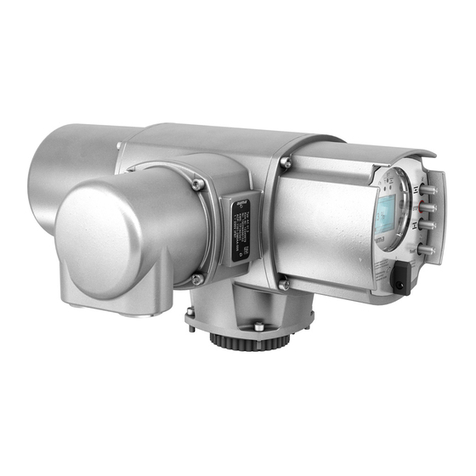
AUMA
AUMA ACE C 01.2 Profinet Series User manual
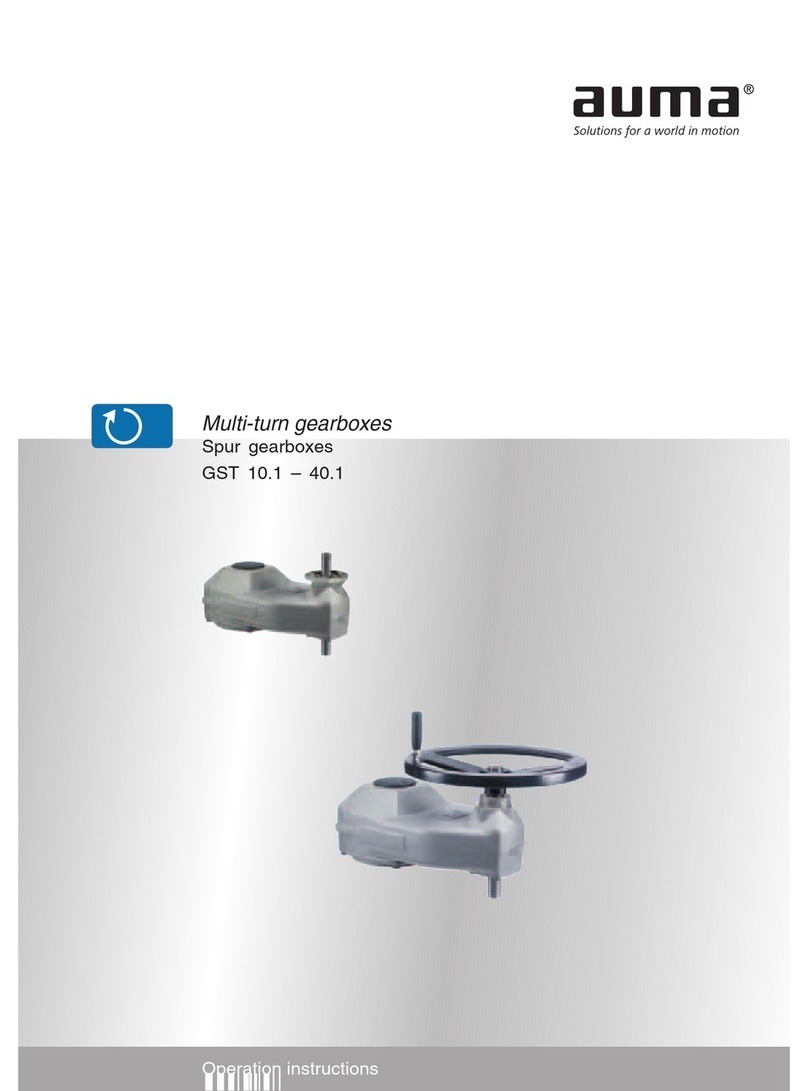
AUMA
AUMA GST 10.1 Administrator Guide

AUMA
AUMA SGM 04.1 User manual

AUMA
AUMA PROFOX PF-M25 Manual

AUMA
AUMA SEVEN 2SA7 Instruction manual
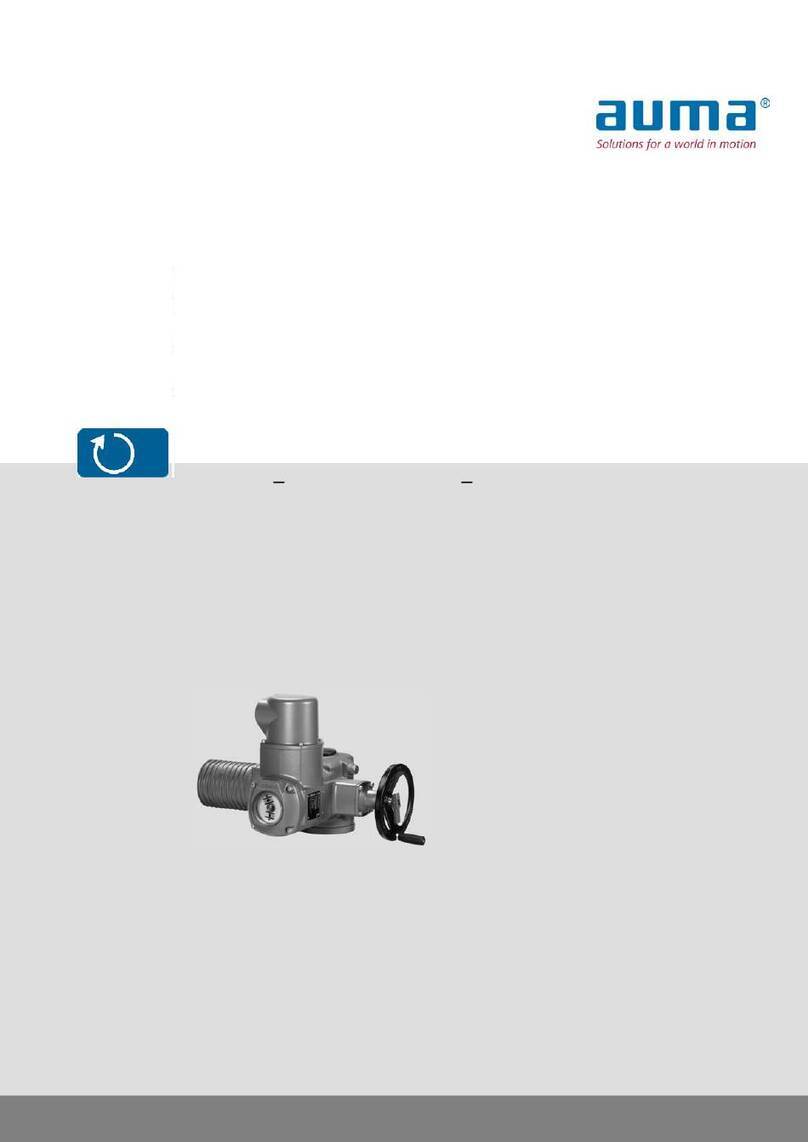
AUMA
AUMA SA 16.1 User manual
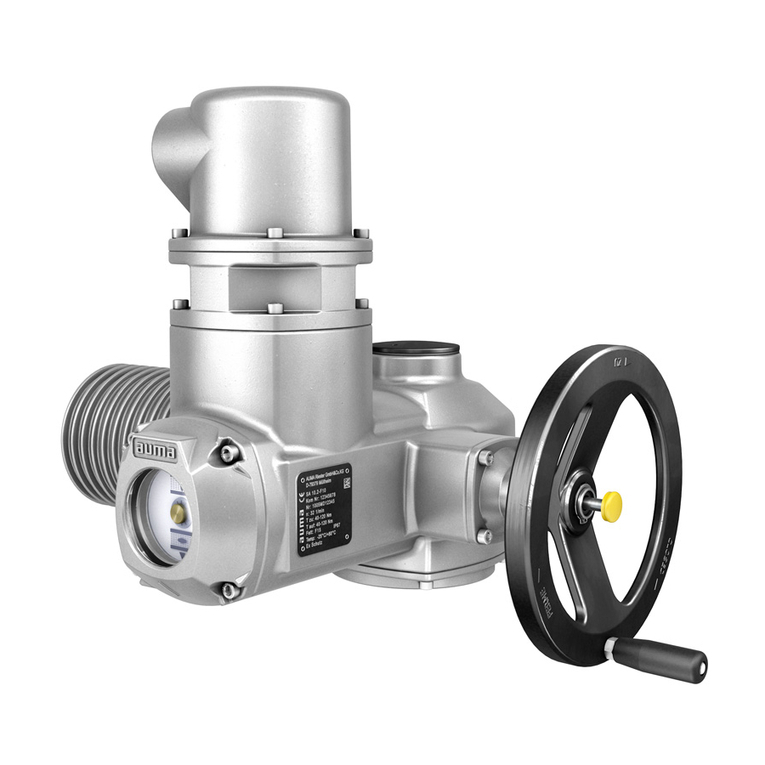
AUMA
AUMA SAEx 07.2 User manual
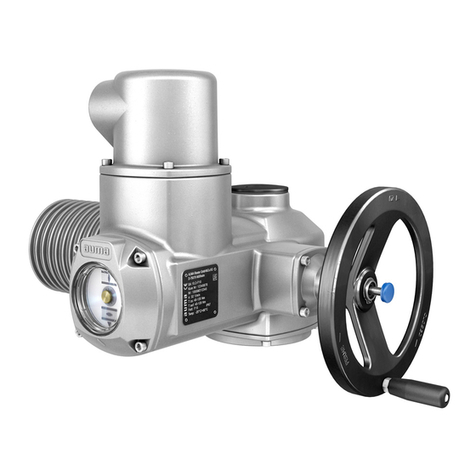
AUMA
AUMA SA 07.2 User manual
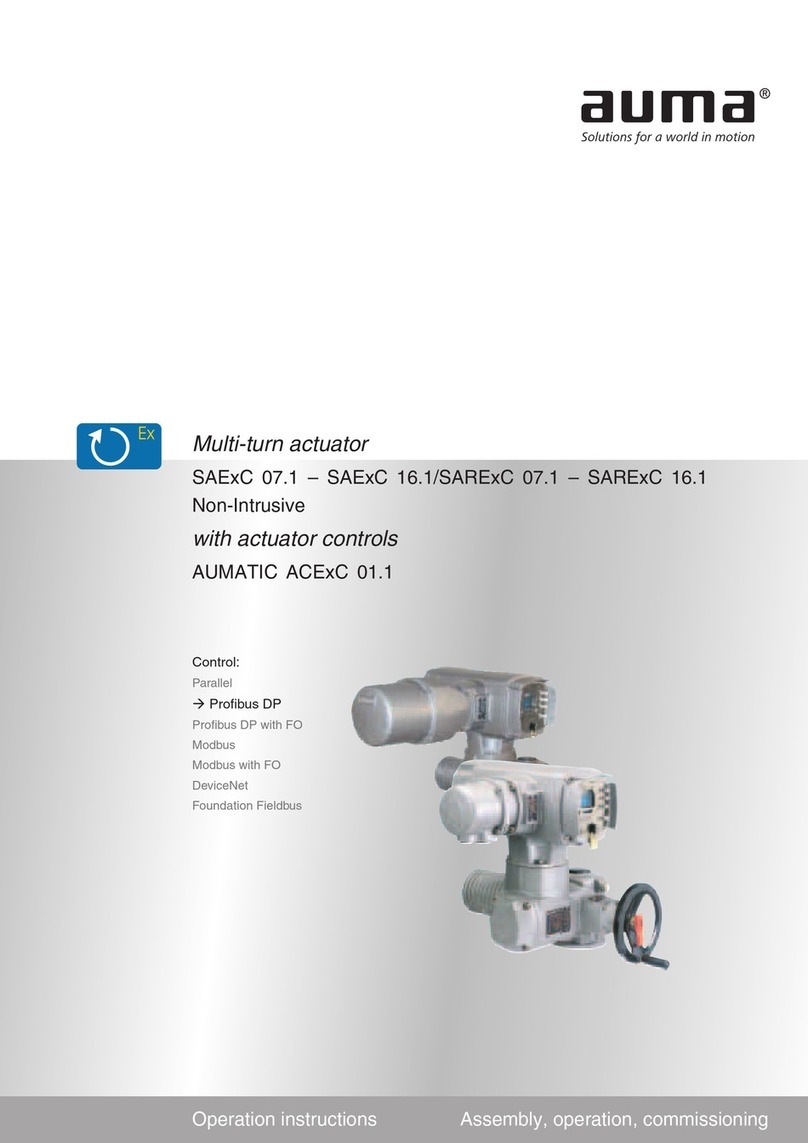
AUMA
AUMA SAExC 07.1 User manual
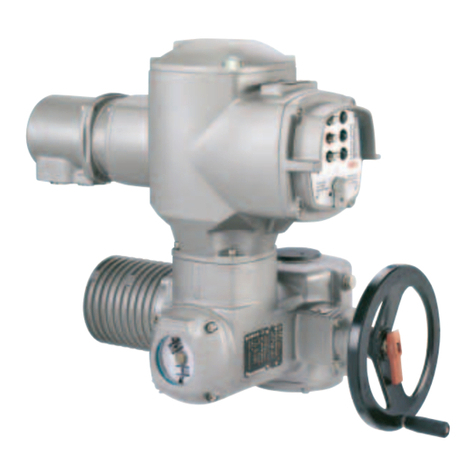
AUMA
AUMA SA 07.1 - SA 30.1 User manual
Popular Controllers manuals by other brands
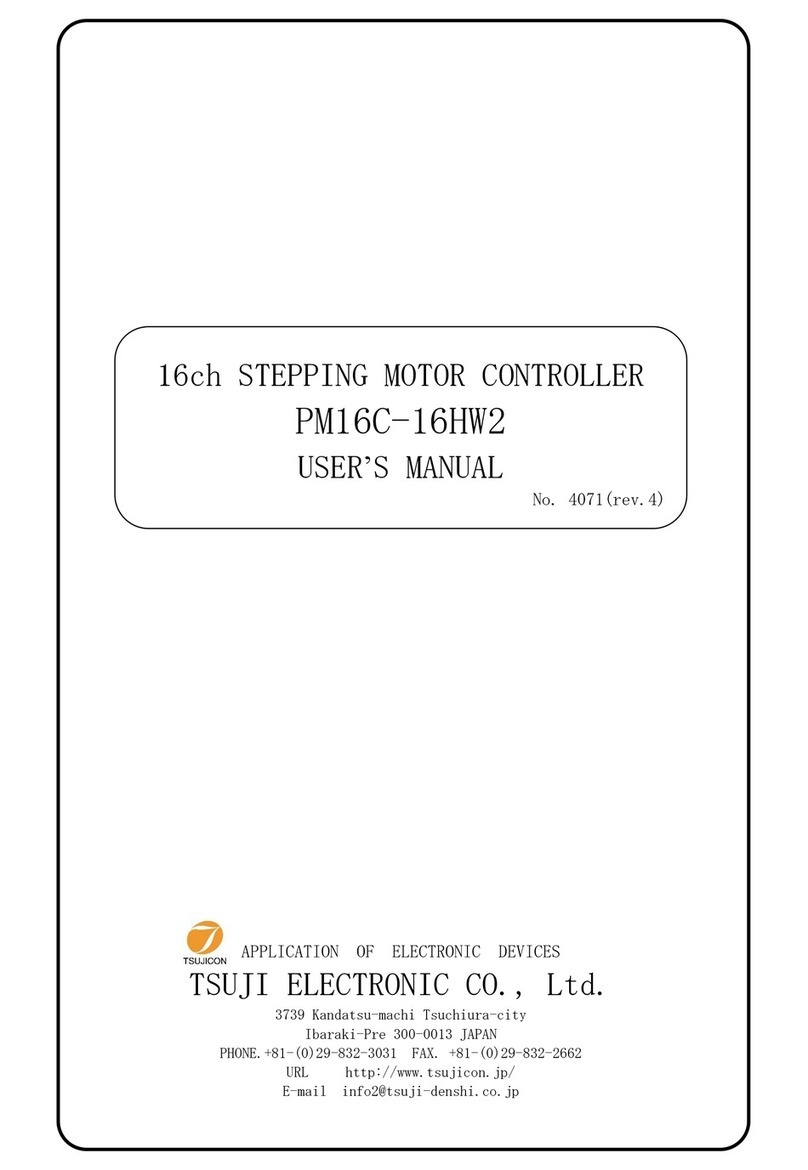
TSUJI ELECTRONICS
TSUJI ELECTRONICS PM16C-16HW2 user manual
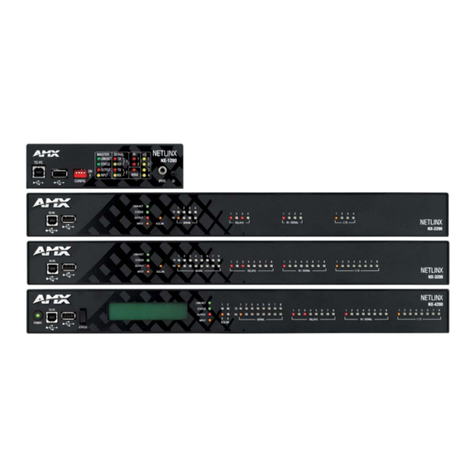
Harman
Harman AMX NETLINX NX Series Hardware reference manual
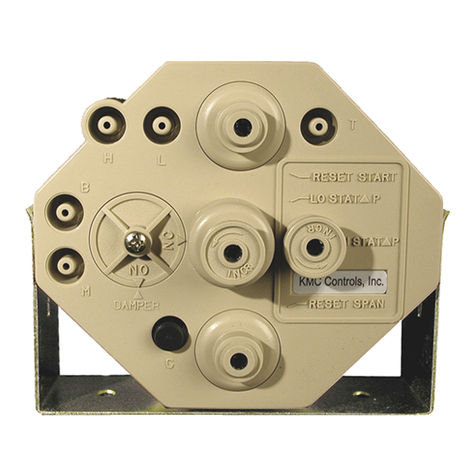
KMC Controls
KMC Controls CSC 3000 Series Application guide
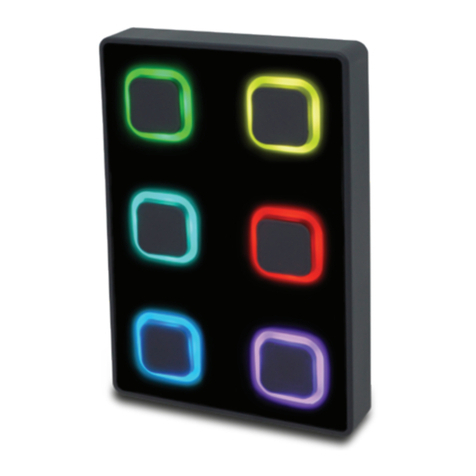
Visual Productions
Visual Productions B-STATION2 manual

Shimaden
Shimaden PAC18A Series instruction manual
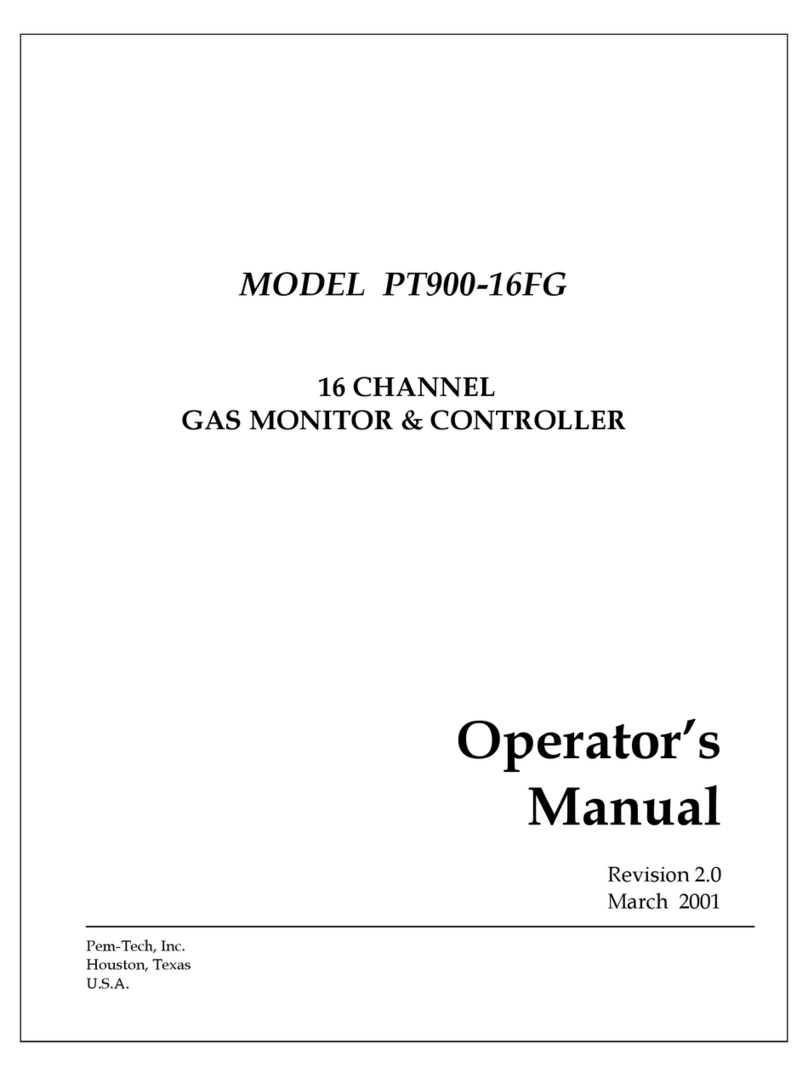
PEMTECH
PEMTECH PT900-16FG Operator's manual
